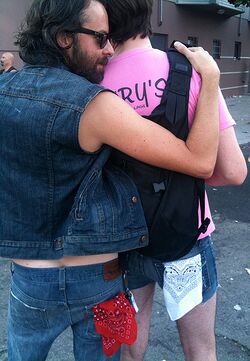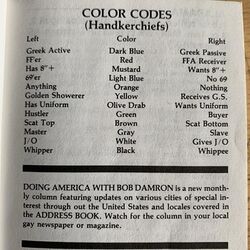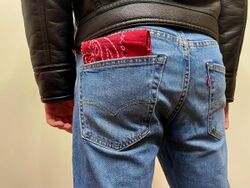Handkerchief code
The handkerchief code (also known as the hanky code, the bandana code, and flagging)[1] is a system of color-coded cloth handkerchief or bandanas for non-verbally communicating one's interests in sexual activities and fetishes. The color of the handkerchief identifies a particular activity, and the pocket it is worn in (left or right) identifies the wearer's preferred role in that activity. Wearing a handkerchief on the left side of the body typically indicates one is a "top" (considered active in the act/fetish indicated by the color of the handkerchief) while wearing it on the right side of the body would indicate one is a "bottom" (considered passive in it). For example, a dark blue handkerchief indicates an interest in anal sex, and wearing it in the left pocket indicates a preference for being the penetrating partner. The code was first used in the 1970s in the United States, Canada, Australia, and Europe, by gay and bisexual men seeking casual sex or BDSM practitioners. Over time the colors and types of apparel in use have greatly proliferated.
Origin
The wearing of colored bandanas around the neck as a practical accessory was common in the mid- and late-nineteenth century among cowboys, steam railroad engineers, and miners in the Western United States. It is thought that the wearing of bandanas by gay men originated in San Francisco after the Gold Rush, when, because of a shortage of women, men dancing with each other in square dances developed a code wherein the man wearing the blue bandana took the male part in the square dance, and the man wearing the red bandana took the female part (these bandanas were usually worn around the arm or hanging from the belt or in the back pocket of one's jeans).[2]
In the 1970s, the modern hanky code developed as a semiotic system of sexual advertising popular among the gay leather community of the United States[3] and cruising scene more broadly.
The origin of the modern hanky code is disputed. The modern hanky code is often reported to have started in New York City around 1970, when a journalist for the Village Voice joked that instead of simply wearing a set of keys on one side or the other (then a common code to indicate whether someone was a "top" or a "bottom"), it would be more efficient to subtly announce their particular sexual focus by wearing different colored handkerchiefs.[4][5][6] However, other sources attribute the expansion of the original red–blue system into today's code to marketing efforts around 1971 by The Trading Post, a San Francisco department store for erotic merchandise, promoting handkerchiefs by printing cards listing the meanings of various colors.[7] Meanwhile, Alan Selby, founder of Mr. S Leather in San Francisco, claimed that he created the first hanky code with his business partners at Leather 'n' Things in 1972, when their bandana supplier inadvertently doubled their order and the expanded code would help them sell the extra colors they had received.[8]
Around 1980, Bob Damron's Address Book published a yearly chart for the meaning of each colored handkerchief.[2]
Examples
There is no single authoritative standard for the code, but there is broad agreement on the definition of certain colors. This table is drawn from Larry Townsend's The Leatherman's Handbook II (the 1983 second edition; the 1972 first edition did not include this list) and is generally considered authoritative. Implicit in this list is the concept of left/right polarity, left as usual indicating the top, dominant, or active partner; right the bottom, submissive, or passive partner. Townsend noted that discussion with a prospective partner is still important because people may wear a given color "only because the idea of the hankie turns them on" or "may not even know what it means".[9]
| Color | Meaning |
|---|---|
| Black | S&M |
| Dark Blue | Anal sex |
| Light Blue | Oral sex |
| Brown | Scat |
| Green | Hustler/prostitution |
| Grey | Bondage |
| Orange | Anything goes |
| Purple | Piercing |
| Red | Fisting |
| Yellow | Pissing |
Longer, more elaborate lists may be found online, but many of the color variations in them are less often used in practice.
Present day
The hanky code has recently undergone a revival and while the use of handkerchiefs may not be as prevalent, the hanky colors are a common consideration in the choice of leather and fetish gear color.[10]
In popular culture
- In the film Cruising (1980), Detective Steve Burns (Al Pacino) goes into a store and has the handkerchief code explained to him by a hanky salesman (Powers Boothe).
- In the pornographic fisting film Erotic Hands (1980) by Bijou Video, a red handkerchief fills the screen for the opening credits.[11]
- In the early 1980s, Judas Priest frontman Rob Halford made the handkerchief code part of his stage costume.[12] In the music video for "Heading Out to the Highway", Halford can be seen wearing a red handkerchief in his left pocket.
- The hanky code is depicted and explained in the music video for "House of Air" (2017) by Brendan Maclean.[13]
See also
- Homosocialization
- Urban legend of sex bracelets
References
- ↑ Andrews, Vincent (2010). The Leatherboy Handbook. The Nazca Plains Corp.. ISBN 978-1-61098-046-3.
- ↑ 2.0 2.1 Kacala, Alexander (April 25, 2019). "The Handkerchief Code, According to 'Bob Damron's Address Book' in 1980". The Saint. https://www.thesaintfoundation.org/community/hanky-code-bob-damrons-address-book.
- ↑ Reilly, Andrew; Saethre, Eirik J. (2013-10-01). "The hankie code revisited: From function to fashion" (in en). Critical Studies in Men's Fashion 1: 69–78. doi:10.1386/csmf.1.1.69_1.
- ↑ Stryker, Susan; Van Buskirk, Jim (1996). Gay by the Bay: A History of Queer Culture in the San Francisco Bay Area. San Francisco: Chronicle Books. p. 18. ISBN 0-8118-1187-5.
- ↑ Hsieh, Carina (2020-07-02). "What Is the Hanky Code?" (in en-US). https://www.cosmopolitan.com/sex-love/a33078811/what-is-hanky-code-how-to-use/.
- ↑ "Fifty Shades of Gay – The Hanky Code" (in en-US). 2019-04-23. https://www.ambushmag.com/fifty-shades-of-gay-the-hanky-code/.
- ↑ Fischer, Hal (1977). Gay Semiotics ♂. San Francisco: NFS Press. ISBN 0-917986-03-2. http://www.queerculturalcenter.org/Pages/HalPages/GaySempg2.html. Retrieved 2017-06-23. "In San Francisco, the signs began appearing around 1971. The Trading Post, a department store specializing in erotic merchandise, began promoting handkerchiefs in the store and printing cards with their meanings. The red and blue handkerchiefs and their significance were already in existence, and meanings were assigned to other colors as well."
- ↑ Jones, Jordy (2017). The Mayor of Folsom Street, The Auto/Biography of "Daddy Alan" Selby aka Mr. S. Fair Page Media LLC. pp. 61–62. ISBN 978-0-9989098-0-6.
- ↑ Townsend, Larry (1983). The Leatherman's Handbook II. New York: Modernismo Publications. p. 26. ISBN 0-89237-010-6.
- ↑ Networks, Hornet (2022-02-11). "We're Loving the Push to Revive the Hanky Code for a New Queer Population" (in en). https://hornet.com/stories/new-hanky-code/.
- ↑ "Erotic Hands". https://gay.aebn.com/gay/movies/125210/erotic-hands.
- ↑ Halford, Rob (2020). Confess. Headline Publishing Group. pp. 163. ISBN 978-1-4722-6928-7.
- ↑ Reynolds, Daniel (2017-02-08). "Is This Raunchy Music Video Art or Explicit Content?" (in en). https://www.advocate.com/music/2017/2/08/music-video-art-or-gay.
Further reading
- Jacques, Trevor H. (1993). On the Safe Edge: A Manual for SM Play. Toronto: Whole SM Publishing. ISBN 978-1-89585-705-4.
 |





